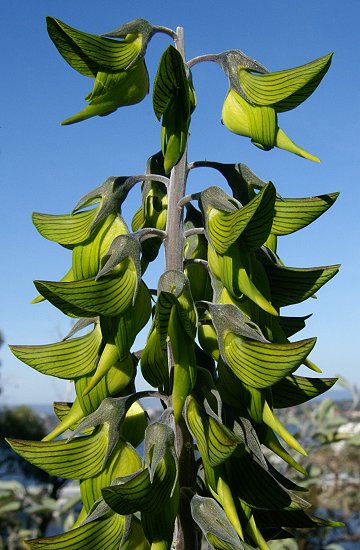
|
|
Green birdflower
(Crotalaria cunninghamii).
|
Green birdflower - Crotalaria cunninghamii
Crotalaria cunninghamii, also known as green birdflower, birdflower ratulpo, parrot pea or regal birdflower, is a plant of the legume family
Fabaceae. It is a short-lived perennial plant native to Australia and its habitat is the deserts, coastlands, drainage lines and sand dunes of the northern half of Western Australia and the Northern Territory. This habitat is semi-arid to temperate regions in well drained soils. Crotalaria cunninghamii blooms from January to April. It is pollinated by large bees and by honeyeaters.
Crotalaria cunninghamii is a shrub growing 1 - 3 metres tall. The plant is harvested from the wild for local use as a medicine and source of fibre. The fibre is of high quality and has potential for commercial production. The plant is also grown as an ornamental in gardens, valued especially for its large, coloured flowers.
The plant named Crotalaria after the Greek word for rattle, because their seeds rattle, and cunninghamii after early 19th century botanist Allan Cunningham.
Crotalaria cunninghamii was identified By Alan Cunningham on a naval expedition in North Western Western Australia in the 1810s. During a seven-month trip to North Western Western Australian in 1817, Cunningham collected more than 300 different species, one of which was Crotalaria cunninghamii.
The green birdflower is a perennial shrub that grows to about 1–3 m in height. It has hairy or woolly branches and dull green foliage. The oval leaves are about 30 mm long, the large and greenish pea flowers are streaked with fine black lines, and the club-shaped seed pods are up to 50 mm long. The plant's flowers grow on long spikes at the ends of its branches. The flower greatly resembles a bird attached by its beak to the central stalk of the flowerhead.
The flowers are mainly green, but can have purple spots and stripes on the 'wings'. The flowers are partially covered in hairy lobes. Crotalaria cunninghamii is non-allergenic and its pods are large and almost square and are covered in a soft, green hairy shell.
The appearance of the flowers of Crotalaria cunninghamii has been debated whether it resembles a bird by natural selection or if it is due to chance. The debate is whether the flowers are bird shaped to ward off unwanted predators or to attract certain pollinators, known as Batesian mimicry, or if it is just by chance that they look like birds and humans have associated the shape of the flower with a bird, known as pareidolia.
Ultimately, researchers concluded that the plant's distinctive hummingbird-like features were likely an adaptation for consistent bird pollination. Michael Whitehead from the University of Melbourne stated that the shape of the flowers are consistent with bird pollination, with its large flowers and long keel on its petals. This makes sense because the predominant pollinators of Crotalaria cunninghamii are nectivorous birds and bees.
Crotalaria cunninghamii habitat is the arid to semi-arid zones to the tropics, including northern Western Australia, the Northern Territory, northern South Australia and southwest Queensland. Crotalaria cunninghamii predominantly grows in well drained soils in shrubland and grassland or savannah woodlands, usually on desert dunes, sandplains and drainage lines. Crotalaria cunninghamii also grows in Mulga communities in arid regions.
Crotalaria cunninghamii has some economic purposes and is a good source of fibre used for weaving.
The stems are a source of fibre. This was used traditionally by the Aboriginal Australians for cords and for making sandals to protect them from the hot desert sand.
The fibre is similar in quality to that obtained from Crotalaria juncea, which is a valuable, high quality, strong fibre that is grown on a commercial basis and used to make twine and cord; canvas and fishing nets; and paper and pulp.
Crotalaria cunninghamii is also a popular ornamental flower because of its unique flower shape.
Crotalaria cunninghamii can also be used to provide medicinal support to humans; through a process of heating and boiling the leaves can be used to treat eye infections and the bark can be used to treat swelling of the limbs. Aboriginal Australians used Crotalaria cunninghamii to treat eye infections and pain. The use of Crotalaria cunninghamii as a medicine is not widespread today, but it has historically been proposed to potentially have use in homeopathy.
Source:
https://en.wikipedia.org/wiki/Crotalaria_cunninghamii
https://tropical.theferns.info/viewtropical.php?id=Crotalaria+cunninghamii
http://timesofindia.indiatimes.com/articleshow/107110949.cms?
